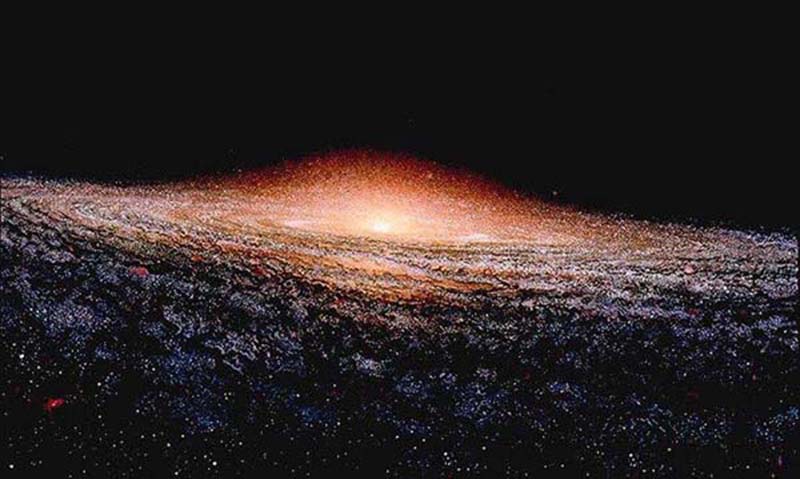

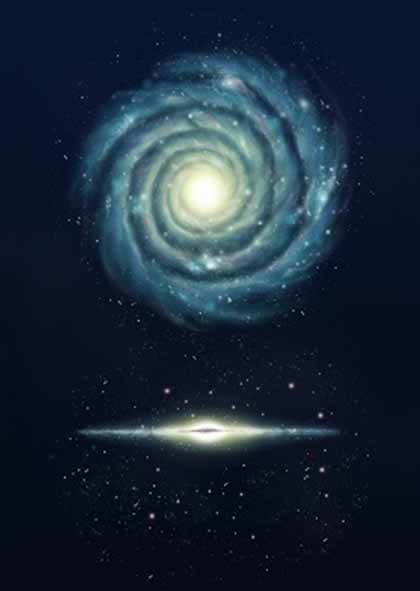
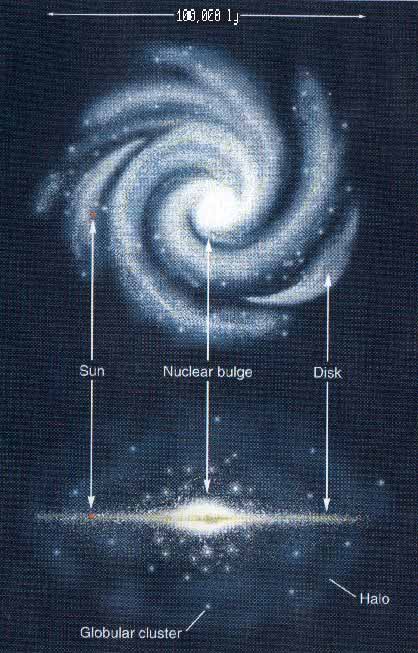
The Milky Way, or simply the Galaxy, is the galaxy in which the Solar System is located. It is a barred spiral galaxy that is part of the Local Group of galaxies. It is one of billions of galaxies in the observable universe. Its name is a translation of the Latin Via Lactea, in turn translated from the Greek Galaxias), referring to the pale band of light formed by the galactic plane as seen from Earth.
When viewed from the Earth and its environs, it appears in the night sky as a hazy band of white light (hence "milky") across the celestial sphere, formed by stars within the disc of its namesake galaxy. It is also simply known as the Galaxy, as the Earth's solar system is a part of it.
The Milky Way looks brightest in the direction of the constellation of Sagittarius, toward the galactic center. Relative to the celestial equator, it passes as far north as the constellation of Cassiopeia and as far south as the constellation of Crux, indicating the high inclination of Earth's equatorial plane and the plane of the ecliptic relative to the galactic plane.
The fact that the Milky Way divides the night sky into two roughly equal hemispheres indicates that the Solar System lies close to the galactic plane. The Milky Way has a relatively low surface brightness, making it difficult to see from any urban or suburban location suffering from light pollution.
Relative to the celestial equator, the Milky Way passes as far north as the constellation of Cassiopeia and as far south as the constellation of Crux. This reflects the fact that the Earth's equatorial plane is highly inclined to the galactic plane, as is the ecliptic (the plane in which the Earth and the other significant planets orbit the Sun). The fact that the Milky Way divides the night sky into two roughly equal hemispheres reflects the fact that the solar system lies close to the galactic plane.
To put the Milky Way into perspective, if you made it 130 km (80 mi) in diameter, our solar system would only be 2 mm (0.08 in) in diameter. Also, if a beam of light were to be shot around the Milky Way, it would take almost 250,000 years to complete its journey.
As Aristotle (384-322 BC) informs us in Meteorologica (DK 59 A80), the Greek philosophers Anaxagoras (ca. 500-428 BC) and Democritus (450-370 BC) proposed that the Milky Way might consist of distant stars. However, Aristotle himself believed the Milky Way to be caused by "the ignition of the fiery exhalation of some stars which were large, numerous and close together" and that the "ignition takes place in the upper part of the atmosphere, in the region of the world which is continuous with the heavenly motions."
The Arabian astronomer, Alhazen (965-1037 AD), refuted this by making the first attempt at observing and measuring the Milky Way's parallax, and he thus "determined that because the Milky Way had no parallax, it was very remote from the earth and did not belong to the atmosphere."
The Persian astronomer, Abu Rayhan al-Biruni (973-1048), proposed the Milky Way galaxy to be a collection of countless nebulous stars.
Avempace (d. 1138) proposed the Milky Way to be made up of many stars but appears to be a continuous image due to the effect of refraction in the Earth's atmosphere.
Ibn Qayyim Al-Jawziyya (1292-1350) proposed the Milky Way galaxy to be "a myriad of tiny stars packed together in the sphere of the fixed stars" and that that these stars are larger than planets.
Actual proof of the Milky Way consisting of many stars came in 1610 when Galileo Galilei used a telescope to study the Milky Way and discovered that it was composed of a huge number of faint stars.
In a treatise in 1755, Immanuel Kant, drawing on earlier work by Thomas Wright, speculated (correctly) that the Milky Way might be a rotating body of a huge number of stars, held together by gravitational forces akin to the Solar System but on much larger scales. The resulting disk of stars would be seen as a band on the sky from our perspective inside the disk. Kant also conjectured that some of the nebulae visible in the night sky might be separate "galaxies" themselves, similar to our own.
The first attempt to describe the shape of the Milky Way and the position of the Sun within it was carried out by William Herschel in 1785 by carefully counting the number of stars in different regions of the visible sky. He produced a diagram of the shape of the Galaxy with the Solar System close to the center.
In 1845, Lord Rosse constructed a new telescope and was able to distinguish between elliptical and spiral-shaped nebulae. He also managed to make out individual point sources in some of these nebulae, lending credence to Kant's earlier conjecture.
In 1917, Heber Curtis had observed the nova S Andromedae within the "Great Andromeda Nebula" (Messier object M31). Searching the photographic record, he found 11 more novae. Curtis noticed that these novae were, on average, 10 magnitudes fainter than those that occurred within our galaxy. As a result he was able to come up with a distance estimate of 150,000 parsecs. He became a proponent of the "island universes" hypothesis, which held that the spiral nebulae were actually independent galaxies.
In 1920 the Great Debate took place between Harlow Shapley and Heber Curtis, concerning the nature of the Milky Way, spiral nebulae, and the dimensions of the universe. To support his claim that the Great Andromeda Nebula was an external galaxy, Curtis noted the appearance of dark lanes resembling the dust clouds in the Milky Way, as well as the significant Doppler shift.
The matter was conclusively settled by Edwin Hubble in the early 1920s using a new telescope. He was able to resolve the outer parts of some spiral nebulae as collections of individual stars and identified some Cepheid variables, thus allowing him to estimate the distance to the nebulae: they were far too distant to be part of the Milky Way. In 1936, Hubble produced a classification system for galaxies that is used to this day, the Hubble sequence.
It is extremely difficult to define the age of the Milky Way but the age of the oldest star in the galaxy yet discovered, HE 1523-0901, is estimated to be about 13.2 billion years, nearly as old as the Universe itself.
This estimate is based on research by a team of astronomers in 2004 using the UV-Visual Echelle Spectrograph of the Very Large Telescope to measure, for the first time, the beryllium content of two stars in globular cluster NGC 6397.
From this research, the elapsed time between the rise of the first generation of stars in the entire galaxy and the first generation of stars in the cluster was deduced to be 200 million to 300 million years. By including the estimated age of the stars in the globular cluster (13.4 - 0.8 billion years), they estimated the age of the oldest stars in the Milky Way at 13.6 - 0.8 billion years. Based upon this emerging science, the Galactic thin disk is estimated to have been formed between 6.5 and 10.1 billion years ago.
The galaxy consists of a bar-shaped core region surrounded by a disk of gas, dust and stars forming four distinct arm structures spiraling outward in a logarithmic spiral shape (see Spiral arms). The mass distribution within the galaxy closely resembles the Sbc Hubble classification, which is a spiral galaxy with relatively loosely-wound arms.
Astronomers first began to suspect that the Milky Way is a barred spiral galaxy, rather than an ordinary spiral galaxy, in the 1990s. Their suspicions were confirmed by the Spitzer Space Telescope observations in 2005 which showed the galaxy's central bar to be larger than previously suspected.
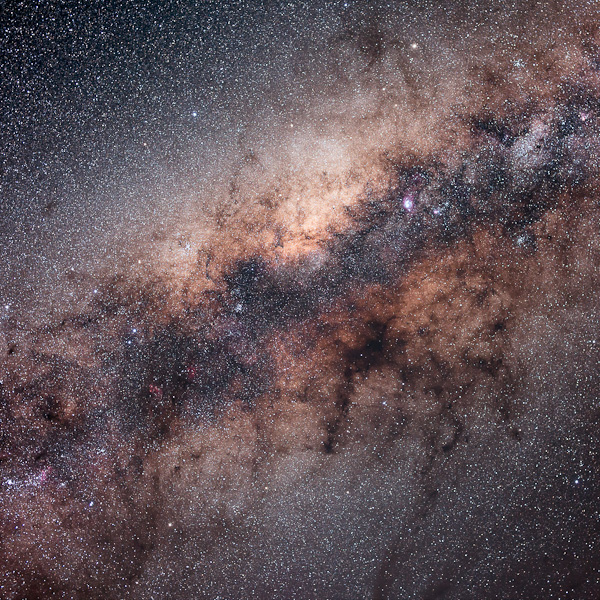
The galactic disc, which bulges outward at the galactic center, has a diameter of between 70,000 and 100,000 light-years. The distance from the Sun to the galactic center is now estimated at 26,000 - 1400 light-years, while older estimates could put the Sun as far as 35,000 light-years from the central bulge.
The galactic center harbors a compact object of very large mass as determined by the motion of material around the center. The intense radio source named Sagittarius A*, thought to mark the center of the Milky Way, is newly confirmed to be a supermassive black hole. For a photo see Chandra X-ray Observatory; Jan. 6, 2003.
On January 5, 2015, NASA reported observing an X-ray flare 400 times brighter than usual, a record-breaker, from Sagittarius A*. The unusual event may have been caused by the breaking apart of an asteroid falling into the black hole or by the entanglement of magnetic field lines within gas flowing into Sagittarius A*, according to astronomers.
Most galaxies are believed to have a supermassive black hole at their center.
The galaxy's bar is thought to be about 27,000 light-years long, running through its center at a 44 - 10 degree angle to the line between the Sun and the center of the galaxy. It is composed primarily of red stars, believed to be ancient. The bar is surrounded by a ring called the "5-kpc ring" that contains a large fraction of the molecular hydrogen present in the galaxy, as well as most of the Milky Way's star formation activity. Viewed from the Andromeda Galaxy, it would be the brightest feature of our own galaxy.
Radio Waves Detected Coming From Center of Galaxy National Geographic - March 2, 2005
Astronomers have detected an unusual, powerful burst of intermittent radio waves emanating from the direction of the center of our galaxy. Now the search is on to trace the source of the mystery radio bursts, or at least find more like it. Was it a dying star "burping" its last radio emissions? Or is there something out there completely new to science? Astronomical radio sources are objects in outer space that emit strong radio waves. Radio emission comes from a wide variety of sources. Such objects represent some of the most extreme and energetic physical processes in the universe.
Bubbles from the Galactic Center: A key to understanding dark matter and our galaxy's past PhysOrg - January 27, 2015
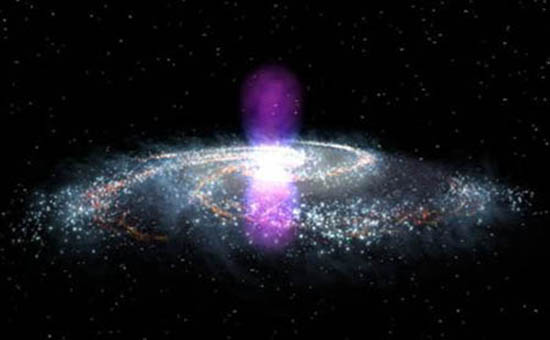
Compared to other galaxies, the Milky Way is a peaceful place. But it hasn't always been so sleepy. In 2010, a team of scientists working at the Harvard-Smithsonian Center for Astrophysics discovered a pair of "Fermi bubbles" extending tens of thousands of light-years above and below the Milky Way's disk. These structures are enormous balloons of radiation emanating from the center of our galaxy. They hint at a powerful event that took place millions of years ago, likely when the black hole at the center of our galaxy feasted on an enormous amount of gas and dust - perhaps several hundreds or even thousands of times the mass of the sun.
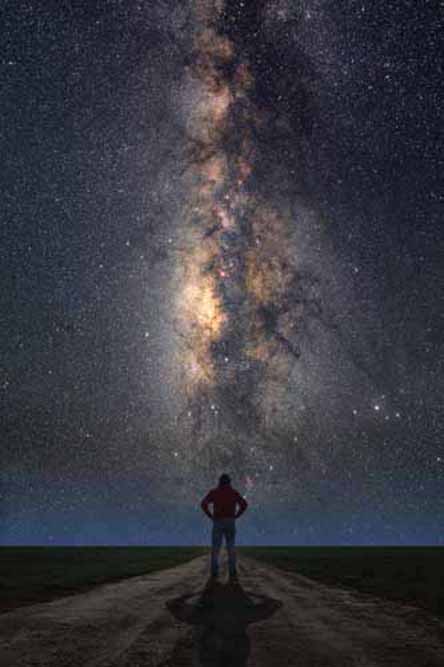


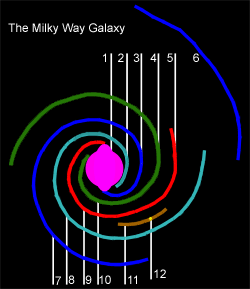
Observed and extrapolated structure of the spiral arms
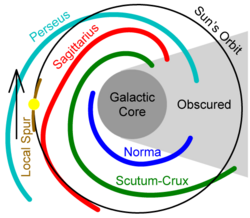
Each spiral arm describes a logarithmic spiral (as do the arms of all spiral galaxies) with a pitch of approximately 12 degrees. There are believed to be four major spiral arms and which all start at the Galaxy's center. These are named as follows, according to the image above.
The Earth's solar system may be found close to the inner rim of this Arm, in the Local Fluff, 8.0-0.5 kpc from the galactic center. The distance between the local arm and the next arm out, the Perseus Arm, is about 6,500 light-years.
Outside of these is the Outer Ring or Monoceros Ring, a proposed ring of stars around the Milky Way by astronomers Brian Yanny and Heidi Jo Newberg. This ring consists of gas and stars torn from other galaxies as they merged with our own billions of years ago.
The disk is surrounded by a spheroid halo of old stars and globular clusters. While the disk contains gas and dust obscuring the view in some wavelengths, the halo does not. Active star formation takes place in the disk (especially in the spiral arms, which represent areas of high density), but not in the halo. Open clusters also occur primarily in the disk.
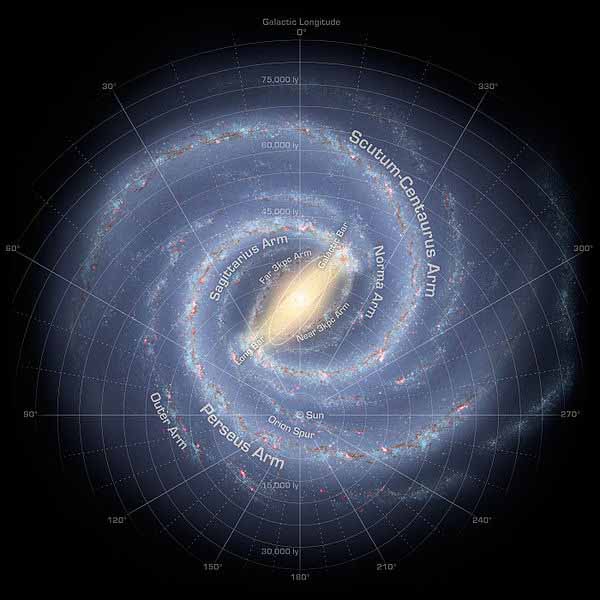
Observations presented in 2008 by Robert Benjamin of the University of Wisconsin-Whitewater suggest that the Milky Way possesses only two major stellar arms: the Perseus arm and the Scutum-Centaurus arm. The rest of the arms are minor or adjunct arms.
This would mean that the Milky Way is similar in appearance to NGC 1365.
Outside of the major spiral arms is the Outer Ring or Monoceros Ring, a ring of stars around the Milky Way proposed by astronomers Brian Yanny and Heidi Jo Newberg, which consists of gas and stars torn from other galaxies billions of years ago.
As is typical for many galaxies, the distribution of mass in the Milky Way Galaxy is such that the orbital speed of most stars in the galaxy does not depend strongly on its distance from the center. Away from the central bulge or outer rim, the typical stellar velocity is between 210 and 240 km/s.
Hence the orbital period of the typical star is directly proportional only to the length of the path traveled. This is unlike the situation within the Solar System, where two-body gravitational dynamics dominate and different orbits are expected to have significantly different velocities associated with them. This difference is one of the major pieces of evidence for the existence of dark matter.
Another interesting aspect is the so-called "wind-up problem" of the spiral arms. If one believes that the inner parts of the arms rotate faster than the outer part, then the galaxy will wind up so much that the spiral structure will be thinned out.
But this is not what is observed in spiral galaxies; instead, astronomers propose that the spiral arms form as a result of a matter-density wave emanating from the galactic center. This can be likened to a moving traffic jam on a highway - the cars are all moving, but there is always a region of slow-moving cars. Thus this results in several spiral arms where there are a lot of stars and gas. This model also agrees with enhanced star formation in or near spiral arms; the compressional waves increase the density of molecular hydrogen and protostars form as a result.
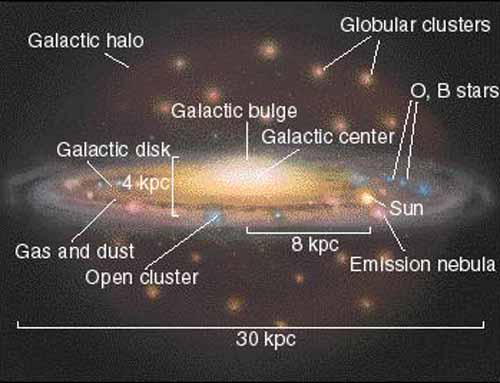

The galactic disk is surrounded by a spheroid halo of old stars and globular clusters, of which 90% lie within 100,000 light-years, suggesting a stellar halo diameter of 200,000 light-years. However, a few globular clusters have been found farther, such as PAL 4 and AM1 at more than 200,000 light-years away from the galactic center.
While the disk contains gas and dust which obscure the view in some wavelengths, the spheroid component does not. Active star formation takes place in the disk (especially in the spiral arms, which represent areas of high density), but not in the halo. Open clusters also occur primarily in the disk.
Recent discoveries have added dimension to the knowledge of the Milky Way's structure. With the discovery that the disc of the Andromeda Galaxy (M31) extends much further than previously thought the possibility of the disk of our own galaxy extending further is apparent, and this is supported by evidence of the newly discovered Outer Arm extension of the Cygnus Arm.
With the discovery of the Sagittarius Dwarf Elliptical Galaxy came the discovery of a ribbon of galactic debris as the polar orbit of the dwarf and its interaction with the Milky Way tears it apart. Similarly, with the discovery of the Canis Major Dwarf Galaxy, it was found that a ring of galactic debris from its interaction with the Milky Way encircles the galactic disk.
On January 9, 2006, Mario Juric and others of Princeton University announced that the Sloan Digital Sky Survey of the northern sky found a huge and diffuse structure (spread out across an area around 5,000 times the size of a full moon) within the Milky Way that does not seem to fit within current models. The collection of stars rises close to perpendicular to the plane of the spiral arms of the galaxy. The proposed likely interpretation is that a dwarf galaxy is merging with the Milky Way. This galaxy is tentatively named the Virgo Stellar Stream and is found in the direction of Virgo about 30,000 light-years away.
The Sun (and therefore the Earth and the Solar System) may be found close to the inner rim of the galaxy's Orion Arm, in the Local Fluff inside the Local Bubble, and in the Gould Belt.
The Sun is currently 5-30 parsecs from the central plane of the galactic disc. The distance between the local arm and the next arm out, the Perseus Arm, is about 6,500 light-years. The Sun, and thus the Solar System, is found in the galactic habitable zone.
There are about 208 stars brighter than absolute magnitude 8.5 within 15 parsecs of the Sun, giving a density of 0.0147 such stars per cubic parsec, or 0.000424 per cubic light-year. On the other hand, there are 64 known stars (of any magnitude, not counting 4 brown dwarfs) within 5 parsecs of the Sun, giving a density of 0.122 stars per cubic parsec, or 0.00352 per cubic light-year (from List of nearest stars), illustrating the fact that most stars are less bright than absolute magnitude 8.5.
The Apex of the Sun's Way, or the solar apex, is the direction that the Sun travels through space in the Milky Way.
The general direction of the Sun's galactic motion is towards the star Vega near the constellation of Hercules, at an angle of roughly 60 sky degrees to the direction of the Galactic Center.
The Sun's orbit around the Galaxy is expected to be roughly elliptical with the addition of perturbations due to the galactic spiral arms and non-uniform mass distributions. In addition, the Sun oscillates up and down relative to the galactic plane approximately 2.7 times per orbit. This is very similar to how a simple harmonic oscillator works with no drag force (damping) term. These oscillations often coincide with mass extinction periods on Earth; presumably the higher density of stars close to the galactic plane leads to more impact events.
It takes the Solar System about 225-250 million years to complete one orbit of the galaxy (a galactic year), so it is thought to have completed 20-25 orbits during the lifetime of the Sun and 1/1250 of a revolution since the origin of humans.
The orbital speed of the Solar System about the center of the Galaxy is approximately 220 km/s. At this speed, it takes around 1,400 years for the Solar System to travel a distance of 1 light-year, or 8 days to travel 1 AU (astronomical unit).

Broad infrared view of our Milky Way Galaxy from the Spitzer Space Telescope created from more than 800,000 frames. This is the most detailed infrared picture of our galaxy to date.
The Milky Way and the Andromeda Galaxy are a binary system of giant spiral galaxies belonging to a group of 50 closely bound galaxies known as the Local Group, itself being part of the Virgo Supercluster.
Two smaller galaxies and a number of dwarf galaxies in the Local Group orbit the Milky Way. The largest of these is the Large Magellanic Cloud with a diameter of 20,000 light-years. It has a close companion, the Small Magellanic Cloud. The Magellanic Stream is a peculiar streamer of neutral hydrogen gas connecting these two small galaxies. The stream is thought to have been dragged from the Magellanic Clouds in tidal interactions with the Milky Way.
Some of the dwarf galaxies orbiting the Milky Way are Canis Major Dwarf (the closest), Sagittarius Dwarf Elliptical Galaxy, Ursa Minor Dwarf, Sculptor Dwarf, Sextans Dwarf, Fornax Dwarf, and Leo I Dwarf. The smallest Milky Way dwarf galaxies are only 500 light-years in diameter. These include Carina Dwarf, Draco Dwarf, and Leo II Dwarf.
There may still be undetected dwarf galaxies, which are dynamically bound to the Milky Way, as well as some that have already been absorbed by the Milky Way, such as Omega Centauri. Observations through the zone of avoidance are frequently detecting new distant and nearby galaxies. Some galaxies consisting mostly of gas and dust may also have evaded detection so far.
In January 2006, researchers reported that the heretofore unexplained warp in the disk of the Milky Way has now been mapped and found to be a ripple or vibration set up by the Large and Small Magellanic Clouds as they circle the Galaxy, causing vibrations at certain frequencies when they pass through its edges. Previously, these two galaxies, at around 2% of the mass of the Milky Way, were considered too small to influence the Milky Way.
However, by taking into account dark matter, the movement of these two galaxies creates a wake that influences the larger Milky Way. Taking dark matter into account results in an approximately twenty-fold increase in mass for the Galaxy. This calculation is according to a computer model made by Martin Weinberg of the University of Massachusetts, Amherst. In this model, the dark matter is spreading out from the galactic disc with the known gas layer. As a result, the model predicts that the gravitational effect of the Magellanic Clouds is amplified as they pass through the Galaxy.
Current measurements suggest the Andromeda Galaxy is approaching us at 100 to 140 kilometers per second. The Milky Way may collide with it in 3 to 4 billion years, depending on the importance of unknown lateral components to the galaxies' relative motion. If they collide, individual stars within the galaxies would not collide, but instead the two galaxies will merge to form a single elliptical galaxy over the course of about a billion years.
The name is from the Greek root galaxy, meaning "milky," a reference to the Milky Way Galaxy.
There are numerous legends in many traditions around the world regarding the creation of the Milky Way. In particular there are two similar ancient Greek stories that explain the etymology of the name 'Galaxias' and its association with milk.
One legend describes the Milky Way as a smear of milk created when the baby Herakles suckled from the Goddess Hera. When Hera realized that the suckling infant was not her own but the illegitimate son of Zeus and another woman, she pushed it away and the spurting milk became the Milky Way Galaxy. �
Another story tells that the milk came from the goddess Rhea, the wife of Cronus, and the suckling infant was Zeus himself. Cronus swallowed his children to ensure his position as head of the Pantheon and sky god, and so Rhea conceived a plan to save her newborn son Zeus: She wrapped a stone in infant's clothes and gave it to Cronus to swallow. Cronus asked her to nurse the child once more before he swallowed it, and the milk that spurted when she pressed her nipple against the rock eventually became the Milky Way.
Older mythology associates the constellation with a herd of dairy cows/cattle, whose milk gives the blue glow, and where each cow is a star. As such, it is intimately associated with legends concerning the constellation of Gemini, which it is in contact with. Firstly, with Gemini, it may form the origin of the myth of Castor and Polydeuces, concerning cattle raiding. Secondly, again with Gemini, but also with other features of the Zodiac sign of Gemini (i.e. Canis Major, Orion, Auriga, and the deserted area now regarded as Camelopardalis), it may form the origin of the myth of the Cattle of Geryon, one of The Twelve Labours of Herakles.
Civilizations in Eastern Asia believed that the hazy band of stars were "Silvery River" of the Heaven. Also, Altair and Vega were thought to be lovers, who were bound not to meet each other but on the seventh day of the seventh month, Qi Xi (Tanabata in Japan and Chilseok in Korea), when the magpies form the bridge over the galactic river.
The Milky Way Galaxy is the inspiration for the symbol of the Ouroboros. In mythology the Milky Way Galaxy keeps a 'great time cycle' that ends in catastrophic change. This refers to a serpent of light (Milky Way) residing in the heavens, who, when viewed at the galactic central point near Sagittarius, eats its own tail. Suntelia Aion refers to the sun (light) rising out of the mouth of the ouroboros (aion) on the winter solstice December 21, 2012. Ancient historians, and especially Plato, referred to a cycle of catastrophe at the End of that Age.

Event Horizon Telescope reveals magnetic fields at Milky Way's central black hole PhysOrg - December 3, 2015

Most people think of black holes as giant vacuum cleaners sucking in everything that gets too close. But the supermassive black holes at the centers of galaxies are more like cosmic engines, converting energy from infalling matter into intense radiation that can outshine the combined light from all surrounding stars. If the black hole is spinning, it can generate strong jets that blast across thousands of light-years and shape entire galaxies. These black hole engines are thought to be powered by magnetic fields. For the first time, astronomers have detected magnetic fields just outside the event horizon of the black hole at the center of our Milky Way galaxy.
Milky Way may have formed 'inside-out': Gaia provides new insight into Galactic evolution PhysOrg - January 20, 2014
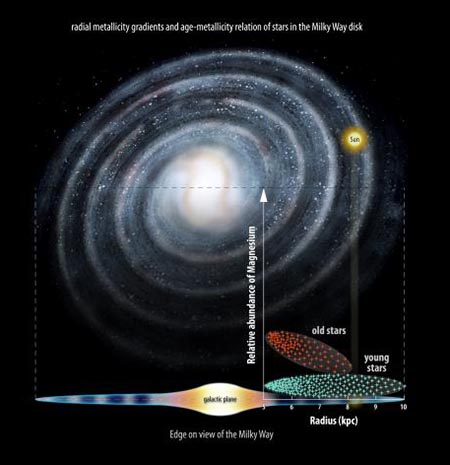
A breakthrough using data from the Gaia-ESO project has provided evidence backing up theoretically predicted divisions in the chemical composition of the stars that make up the Milky Way's disc Ð the vast collection of giant gas clouds and billions of stars that give our Galaxy its 'flying saucer' shape.
Milky Way shaken... and stirred PhysOrg - January 20, 2014
team of scientists headed by Ivan Minchev from the Leibniz Institute for Astrophysics Potsdam (AIP), has found a way to reconstruct the evolutionary history of our galaxy, the Milky Way, to a new level of detail. The investigation of a data set of stars near the Sun was decisive for the now published results. The astronomers studied how the vertical motions of stars - in the direction perpendicular to the galactic disc - depend on their ages. Because a direct determination of the age of stars is difficult, the astronomers instead analyzed the chemical composition of stars: an increase in the ratio of magnesium to iron ([Mg/Fe]) points to a greater age.
The peanut at the heart of our galaxy PhysOrg - September 12, 2013
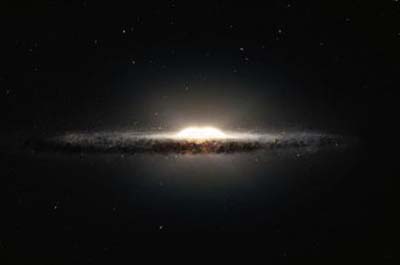
This artist's impression shows how the Milky Way galaxy would look seen from almost edge on and from a very different perspective than we get from the Earth. The central bulge shows up as a peanut shaped glowing ball of stars and the spiral arms and their associated dust clouds form a narrow band. Two groups of astronomers have used data from ESO telescopes to make the best three-dimensional map yet of the central parts of the Milky Way. They have found that the inner regions take on a peanut-like, or X-shaped, appearance from some angles. This odd shape was mapped by using public data from ESO's VISTA survey telescope along with measurements of the motions of hundreds of very faint stars in the central bulge.
Astronomers discover star racing around black hole at Milky Way center PhysOrg - October 4, 2012
UCLA astronomers report the discovery of a remarkable star that orbits the enormous black hole at the center of our Milky Way galaxy in a blistering 11-and-a-half years - the shortest known orbit of any star near this black hole.
Hidden galactic nuclei PhysOrg - August 10, 2012
At the core of most galaxies including our own Milky Way is a massive black hole. Material falling into the environment of the black hole heats up, and can radiate dramatically, sometimes also powering the ejection of bipolar jets of rapidly moving charged particles. These so-called active galactic nuclei (AGN) are observed to have roughly two types of characteristics: bright, rapidly moving hot gas with dust emission features, or dust absorption with modest (or no) fast gas.
Huge "Structure" of Satellites Found Orbiting Milky Way National Geographic - May 1, 2012
A huge "structure" of satellite galaxies and star clusters has been found wheeling around the Milky Way, according to a new study. The discovery surprised scientists, in part because the structure might spell trouble for theories of dark matter, the mysterious, invisible substance that's thought to make up about 23 percent of the mass in the universe. The finding is only the latest to question dark matter's existence - last week, for instance, astronomers announced that they'd failed to detect dark matter in the sun's neighborhood, even though the substance should be there, according to accepted theory.
Astronomers weigh in on Milky Way's true colors BBC - January 12, 2012

Astronomers have determined exactly what color our home galaxy the Milky Way is - and find it is aptly named. They wanted to find out how our galaxy looked from the outside - a difficult task given the Earth is inside it. A comparison of star types in other galaxies gives perhaps an unsurprising result: white. But not just any white: specifically, like spring snow at an hour after sunrise or before sunset.
Astronomers determine color of the Milky Way Galaxy PhysOrg - January 11, 2012
A team of astronomers in Pitt's Kenneth P. Dietrich School of Arts and Sciences announced today the most accurate determination yet of the color of the (aptly named) Milky Way Galaxy: "a very pure white, almost mirroring a fresh spring snowfall."
Coming Face-to-Face With Our Galaxy's Black Hole Discovery - December 19, 2011
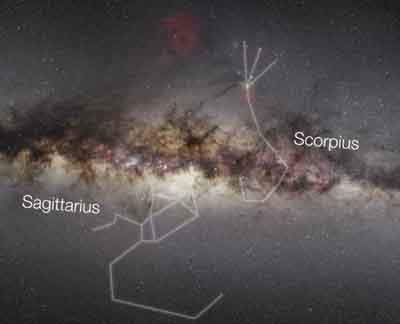
At the center of our galaxy resides an invisible monster, a dark giant composed of the shredded and swallowed remains of stars, nebulae and solar systems. It has captured enormous nearby stars into orbit, causing them to whip around the galactic center at breakneck speeds until they too become just another snack. It may sound like science fiction but all observations indicate it's indeed a fact: a supermassive black hole - called Sagittarius A* - exists. It's real, it's huge, and it's hungry. Sagittarius A* is a monstrous black hole estimated to contain the mass equivalent to 4 million suns, packed into a space less than the distance between Earth and the sun, resulting in an incredibly dense object known as a black hole -- in the case of Sgr A*, a supermassive black hole. Although Sgr A* is itself invisible the effect of its gravity on surrounding stars has been seen, some of which orbit it at speeds of over 600 miles per second!
Voyager Probes Detect "Invisible" Milky Way Glow National Geographic - December 1, 2011
Speeding toward interstellar space, NASA's twin Voyager probes have now truly peered outside the solar system - and they've seen something no human has glimpsed before. According to a new study, the two spacecraft have detected a type of ultraviolet light from other regions of our Milky Way galaxy that had previously been all but invisible due to the sun's glow.
 A planet made of diamond PhysOrg - August 25, 2011
A planet made of diamond PhysOrg - August 25, 2011
A once-massive star that's been transformed into a small planet made of diamond: that is what University of Manchester astronomers think they've found in the Milky Way.
Saturn has rings - this planet has diamonds MSNBC - August 25, 2011
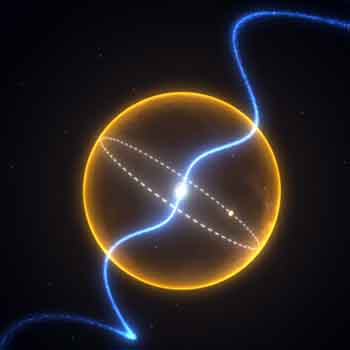
A newly discovered alien planet that formed from a dead star is a real diamond in the rough. The super-high pressure of the planet, which orbits a rapidly pulsing neutron star, has likely caused the carbon within it to crystallize into an actual diamond, a new study suggests. The composition of the planet, which is about five times the size of Earth, is not its only outstanding feature.
"Diamond" Planet Found; May Be Stripped Star Live Science - August 25, 2011
The newfound planet orbits the pulsar so closely the entire system would fit inside the sun. An exotic planet as dense as diamond has been found in the Milky Way, and astronomers think the world is a former star that got transformed by its orbital partner. The odd planet was discovered orbiting what's known as a millisecond pulsar - a tiny, fast-spinning corpse of a massive star that died in a supernova. Astronomers estimate that the newfound planet is 34,175 miles (55,000 kilometers) across, or about five times Earth's diameter.
Space telescopes reveal previously unknown brilliant X-ray explosion in our Milky Way galaxy PhysOrg - October 22, 2010
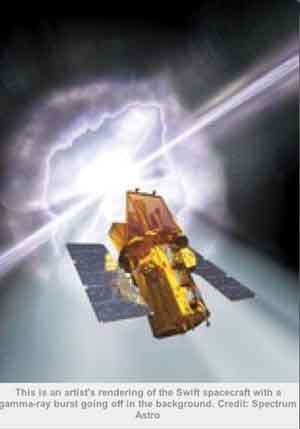
Astronomers in Japan, using an X-ray detector on the International Space Station, and at Penn State University, using NASA's Swift space observatory, are announcing the discovery of an object newly emitting X-rays, which previously had been hidden inside our Milky Way galaxy in the constellation Centaurus.
Scientists get a look at the birth of the Milky Way PhysOrg - June 22, 2010
For the first time, a team of astronomers has succeeded in investigating the earliest phases of the evolutionary history of our home Galaxy, the Milky Way. The scientists, from the Argelander Institute for Astronomy at Bonn University and the Max-Planck Institute for Radioastronomy in Bonn, deduce that the early Galaxy went from smooth to clumpy in just a few hundred million years.
There is a giant black hole at the center of our galaxy, a study has confirmed. BBC - December 10, 2008
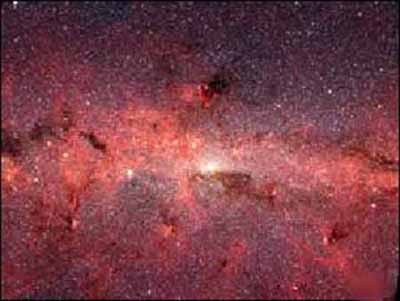
There is a giant black hole at the centre of our galaxy, a 16-year study by German astronomers has confirmed.
They tracked the movement of 28 stars circling the centre of the Milky Way, using two telescopes in Chile.
The black hole, said to be 27,000 light years from Earth, is four million times bigger than the Sun, according to the paper in The Astrophysical Journal. Black holes are objects whose gravity is so great that nothing - including light - can escape them. According to Dr Robert Massey, of the Royal Astronomical Society (RAS), the results suggest that galaxies form around giant black holes in the way that a pearl forms around grit.
Milky Way's Giant Black Hole 'Awoke From Slumber' 300 Years Ago Science Daily - April 17, 2008
Using NASA, Japanese, and European X-ray satellites, a team of Japanese astronomers has discovered that our galaxyÕs central black hole let loose a powerful flare three centuries ago. The finding helps resolve a long-standing mystery: why is the Milky WayÕs black hole so quiescent? The black hole, known as Sagittarius A* (pronounced "A-star"), is a certified monster, containing about 4 million times the mass of our Sun. Yet the energy radiated from its surroundings is billions of times weaker than the radiation emitted from central black holes in other galaxies.
Two Supernova Factories Found In The Milky Way Science Daily - April 2, 2008
Two supernova factories, rare clusters of Red Supergiant (RSG) stars, have been discovered in the Galactic Bar of the Milky Way.
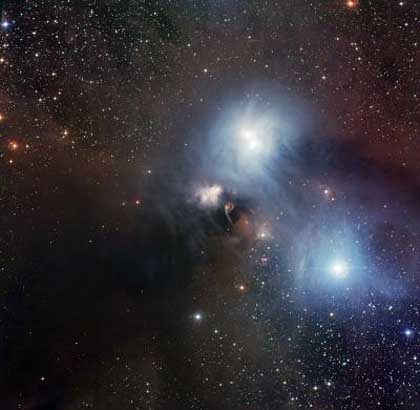
 Music & Video: R Coronae Australis: A cosmic watercolor
Music & Video: R Coronae Australis: A cosmic watercolor
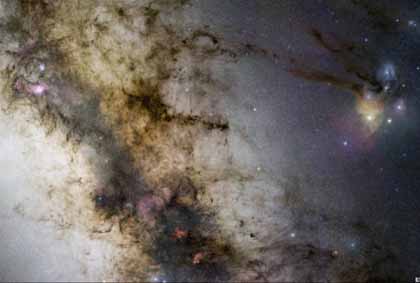
The Hourglass Milky Way Thunderbolts - June 28, 2010
A dipolar "bubble" of gamma radiation from the galactic nucleus
charged dust into a z-pinch compression zone.
Sagittarius and the Central Milky Way
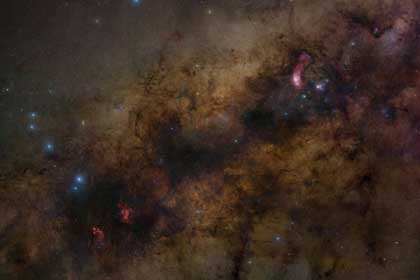
The Milky Way Over Ontario

NASA - July 29, 2008
New spiral arm in the Milky Way - 3kpc Arm
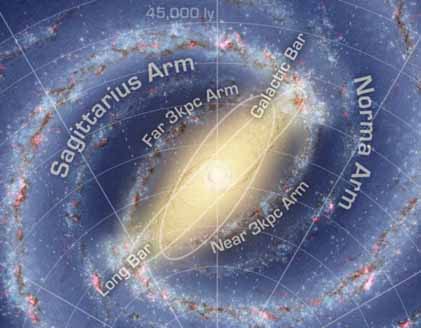
NASA - July 11, 2008
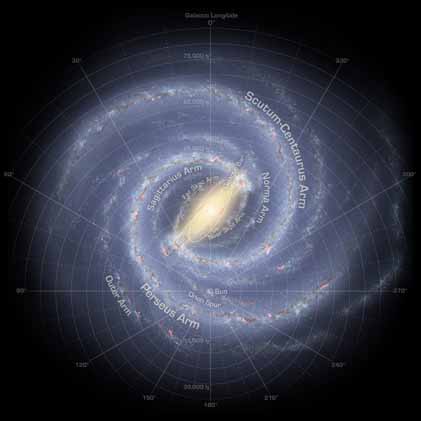
Two-Armed Spiral Milky Way (Animated) NASA - June 6, 2008
New Milky Way Map Created; Shows Two Fewer Main Arms
National Geographic - June 3, 2008
The Bird is the Word
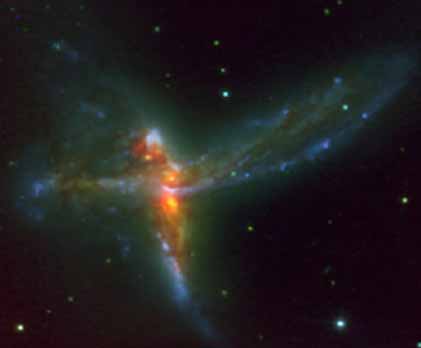
Thunderbolts - June 10, 2008
Stars and Dust through Baade's Window
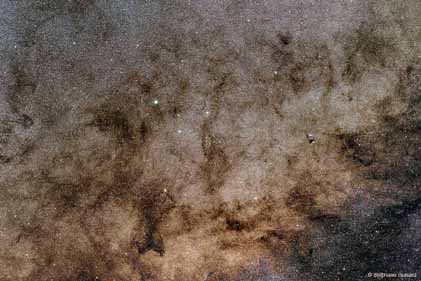
NASA - December 19, 2007
Sky Over the Grand Tetons, Wyoming

NASA - August 13, 2007
Old Faithful Below a Yellowstone Sky
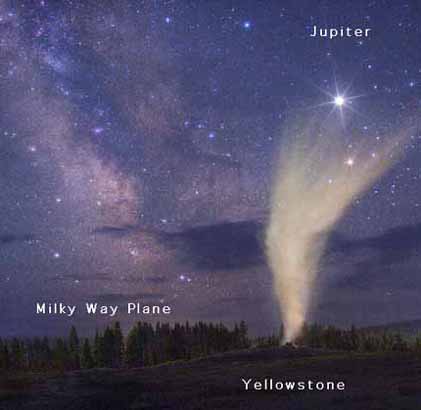
NASA - August 7, 2007
A Laser Strike at the Galactic Center
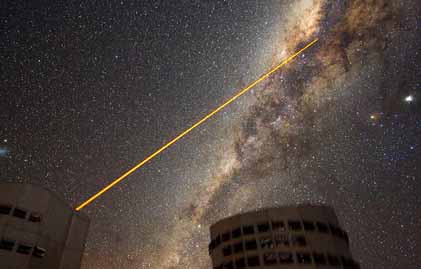
NASA - July 31, 2007
Stars of the Galactic Center
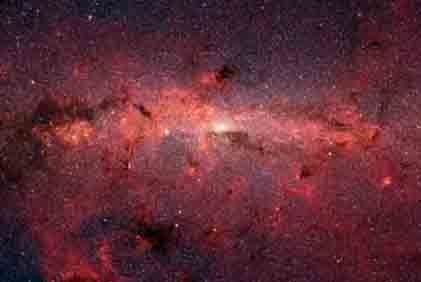
NASA - February 10, 2007